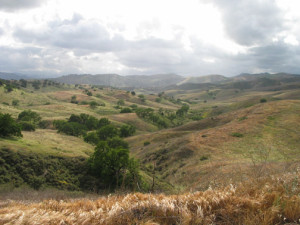Ahmanson foes want ground-water tests
By Michael Collins
LA Weekly – June 12, 2002
 Elizabeth Crawford sits astride her black thoroughbred Rufus under a live oak on Ahmanson Ranch in eastern Ventura County, and gazes toward thousands of acres of golden hills. Seattle-based Washington Mutual‘s Ahmanson Land Company (ALC) wants to build 3,050 luxury manses on 2,783 acres of this pristine property on Los Angeles County’s western flank.
Elizabeth Crawford sits astride her black thoroughbred Rufus under a live oak on Ahmanson Ranch in eastern Ventura County, and gazes toward thousands of acres of golden hills. Seattle-based Washington Mutual‘s Ahmanson Land Company (ALC) wants to build 3,050 luxury manses on 2,783 acres of this pristine property on Los Angeles County’s western flank.
The big bank envisions greenbacks in these bluffs, but the 43-year-old mother of three is seeing red. ”Way up there, the northeastern border of Ahmanson Ranch directly abuts the radiological area of Rocketdyne, and we have evidence that radiological and chemical contaminants from that facility may have polluted the ranch,“ Crawford says. ”Yet we can‘t be sure because the developers haven’t done adequate testing of the soil and no examination of the ground water for possible Rocketdyne-related poisons.“
Opponents of the project will have one of their last chances to raise concerns at a June 19 public hearing convened by the Ventura County Board of Supervisors‘ environmental report review committee. The committee will decide whether a supplemental environmental report adequately addresses any problems construction may cause for the endangered California red-legged frog and the San Fernando Valley spineflower plant. The committee also is expected to evaluate whether chemicals from the laboratory seep into the site’s ground water.
”Some people have said that the EIR is not adequate and that additional issues should be addressed and that a whole new EIR should be done,“ said Dennis Hawkins, senior planner for the Ventura County Resource Management Agency.
The future of the site appears far from decided. Last week, Governor Davis‘ administration voiced support for acquiring the Ahmanson Ranch as open space, though it’s unclear where the money would come from. And state Senator Sheila Kuehl (D–Los Angeles) recently introduced a bill that would require contaminated sites to be cleaned up to the strictest EPA standards.
Rocketdyne‘s 2,668-acre Santa Susana Field Laboratory (SSFL) opened in 1948 and became a key supplier of America’s rapidly expanding Cold War arsenal of nuclear weapons and rocket engines for the space race. The now-closed facility has had many pollution problems, including partial meltdowns of experimental nuclear reactors in 1959 and 1964, and is in the midst of a $258 million cleanup. The field laboratory‘s ground water contains trichloroethylene, or TCE, a carcinogenic solvent used to clean rocket engine hardware.
The Ahmanson Land Company’s position has been that its area is clean, based on tests completed as recently as April. Others disagree. ”The scope of the tests and the basis for analysis were highly limited, and skewed in order to produce the desired results,“ says attorney Ed Masry of Westlake Village. Crawford, Masry and Mary Weisbrock, director of Save Open Space, all point to the fact that no sampling of the project‘s ground water has been done and that only three surface-water samples have been analyzed. Even so, one surface-water sample detected highly radioactive strontium 90 at a level eight times higher than limits set by the federal Environmental Protection Agency. ”They must analyze the ground water for pollution since they plan to use 660,000 gallons of it every day to water playgrounds, golf courses, common areas and lawns,“ says Weisbrock. Less than two miles from the field lab, the Ahmanson Land Company ”plans to extract ground water for irrigation.“
The Rocketdyne property, which sits high on the hills above Ahmanson Ranch, is riddled with earthquake faults. Geologists disagree about whether chemicals could end up in Ahmanson’s ground water. A 2000 report by one of ALC‘s contractors, Kleinfelder Inc., discounts any chance of ground-water contamination. The Rocketdyne property and the Ahmanson Ranch Project are ”characterized by different watersheds and separate aquifers.“
Opponents of the project point out that the field laboratory is above the so-called Chatsworth formation, a fractured-bedrock geologic configuration that could allow for toxic migration. James Slosson, chief engineering geologist for Van Nuys–based Slosson and Associates, agrees. ”It is my professional opinion that a portion of the subsurface water exiting the Rocketdyne facility migrates southerly in the direction of [the proposed development’s ground-water extraction] wells. As a consequence, the extracted water may contain toxic contaminants from the Rocketdyne operation which will present a health hazard,“ Slosson wrote in an April 30 missive to the county of Ventura‘s Resource Management Agency. ”The surface runoff from the golf courses could also be contaminated. Much of this runoff would eventually reach Las Virgenes Creek and Malibu Lagoon.“
The ground water at the massive project is not the only concern of opponents. An estimated 43 million cubic yards of soil, the equivalent of 55 Rose Bowls of dirt, would be excavated, creating 23,000 tons of dust made airborne during construction.
But just what is in that soil? Kleinfelder tested six samples, averaging one for every 464 acres of the proposed construction of luxury homes. The soil samples were taken at a 6-inch depth, which opponents say is too shallow, by as much as 100 feet. Says attorney Masry: ”If suspected contaminants are in the soil, testing should be done down to the depth that the soil will be graded.“












Recent Comments